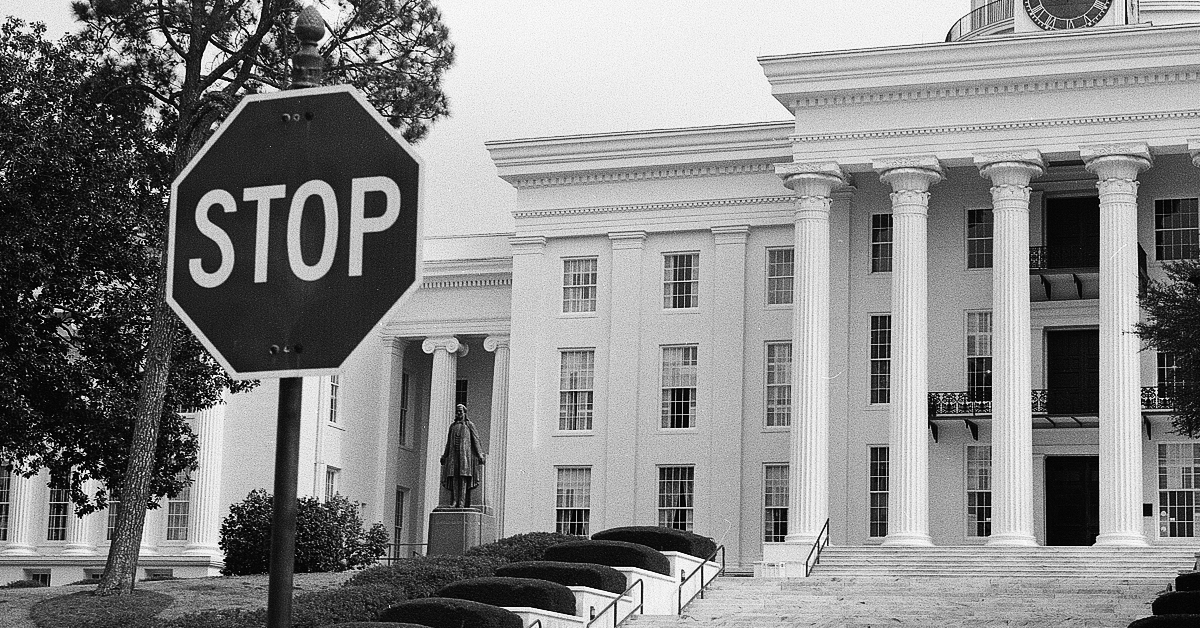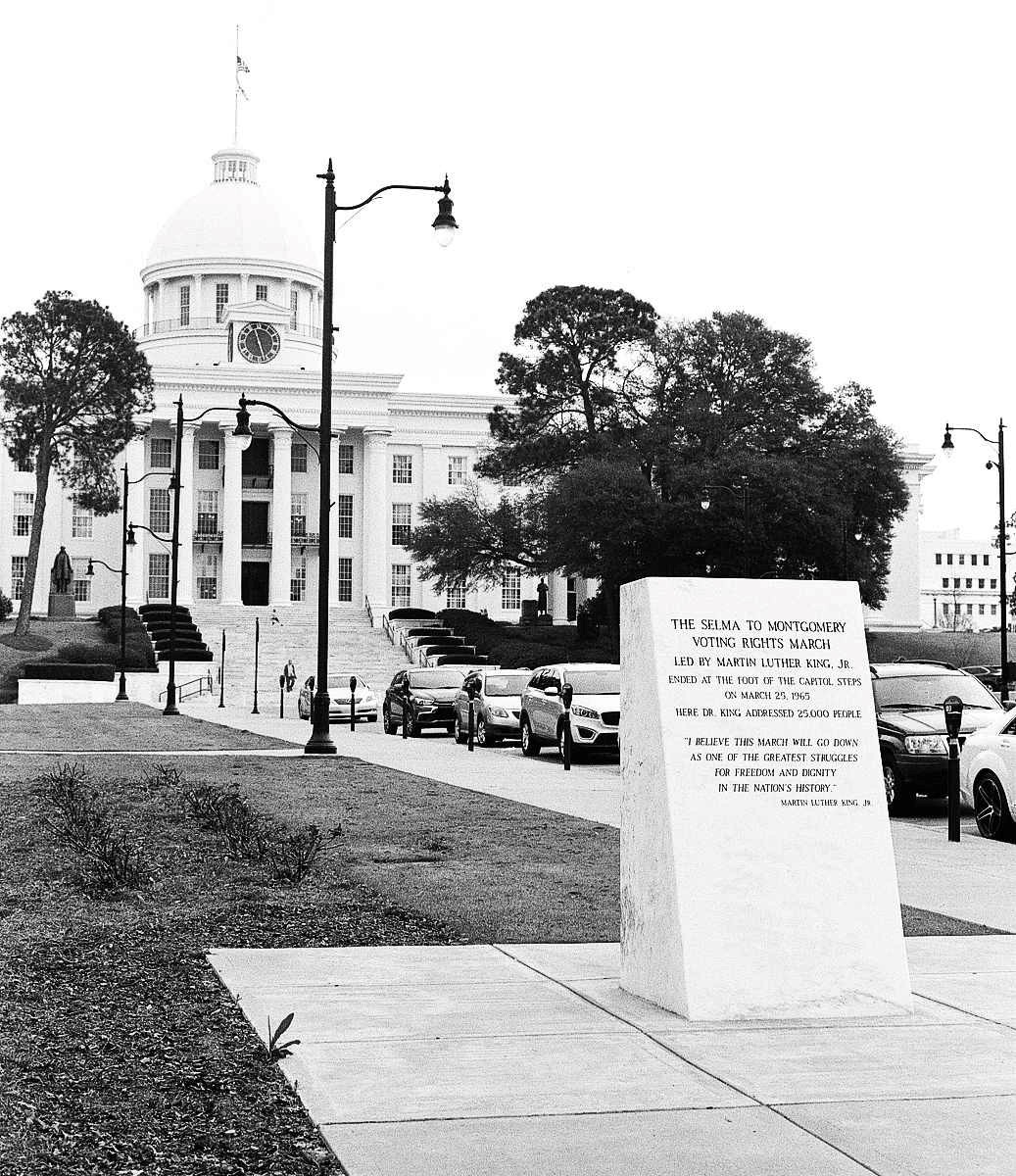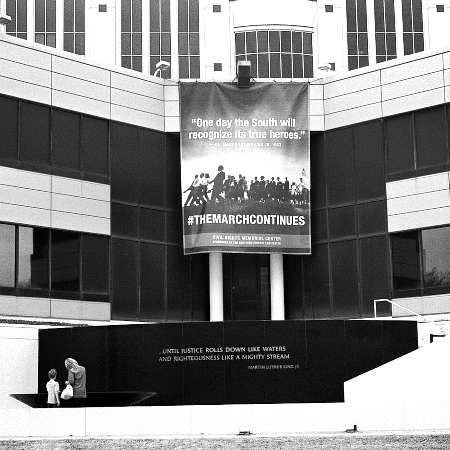 Commentary
CommentaryThis essay describes a walk not taken with my students. Here is a pdf version for anyone that might like to have a copy of this material for personal or educational use.
The purpose of the walk was to show one thing: a big monument cannot fix a small person or a bad idea.
This insight requires a certain perspective—one with implications for law and politics.
The lesson of the walk relates to current events in America and, importantly, the role of contract law in those events. But—it is a winding road, with twists and turns aplenty.
As background, I had planned a field trip for law students to Montgomery, Alabama for spring break—March 2020. The COVID-19 crisis postponed this teaching moment. Current events prompt me to share my lesson now, as best I can, because an in-person visit remains impossible. So much has happened since I first imagined this trip…
The walk begins at the Alabama State Legislature building in front of a statue of Jefferson Davis, the first president of the Confederacy.

Photo Credit: (c) William H. Widen
You turn around to share the gaze of the statue. You look down Dexter Avenue. In the distance, you spot a simple red brick church with a white steeple. Dr. Martin Luther King, Jr., once led the congregation that worships at this church.

Photo Credit: (c) William H. Widen
This juxtaposition speaks for itself. The figure of a white supremacist looks down on an African American church.
Continue to walk with me down the hill on the left side of Dexter Avenue.
Not 50 feet from Dr. King’s church you find a small memorial stone commemorating the inauguration of Jefferson Davis.
But look closely.
The memorial stone is weathered and a bit dingy. The photo needed enhancement to even read the inscription. Commemorating the first playing of “Dixie” as a band arrangement does not inspire. Out of the corner of your eye, you see the statue of Jefferson Davis in front of the state legislature building.
It looks small. Really small.

Photo Credit: (c) William H. Widen
You look across Dexter Avenue and you see another commemorative marker, so you cross the street. There you find a memorial stone of a different sort.
This second memorial stone commemorates the Selma to Montgomery voting rights march.

Photo Credit: (c) William H. Widen
Bright in visage and message, it states:
I believe this march will go down as one of the greatest successes for freedom and dignity in the nation’s history.—Martin Luther King, Jr.
The statue of Jefferson Davis, visible in the background, looks even smaller when contrasted with these words. Remembrance of this march—a celebration of freedom and dignity—further diminishes the monument. Today, the statue symbolizes an unjust social order.
The banality of the reference to the arrangement of “Dixie” across the street comes into sharper focus.
But a student might ask, “What does this walk have to do with contract law, Professor Widen?”
My answer: “Contract law relates to the walk—but you must look and think beyond the surface of the situation”.
Contract law is a tool. Society uses contract law for good, as well as ill, to structure relationships among and between people and things. It forms the underpinnings of corporate law—confirmed in the U.S. in a “contracts clause” case, namely Dartmouth College v. Woodward (1819).
Scholars have theorized the corporation as nothing more than a “nexus of contracts”—a legal personality, but no soul. Corporations have parlayed status as legal persons to benefit from laws passed to protect human beings, seeking constitutional rights and protections early in our history as in Bank of the United States v. Deveaux (1809).
The effort finally succeeded in Santa Clara County v. Southern Pacific Rail Road (1886), when the Court granted a corporation the same rights as an individual under the 14th Amendment (or so the case has been interpreted).
Corporations now enjoy a right to freedom of speech which injects money into politics in ways that jeopardize the promise of “freedom and dignity” sought by the Selma to Montgomery march for voting rights, honored with the memorial stone on Dexter Avenue. This can be seen no more clearly than in the Citizens United v. Federal Election Com’n (2010) decision.
Decisions which grant rights intended as human rights to the legal personality of a corporation contain political risk for a democracy if conferred blindly, and without limit.
In his dissent in Citizens United, Justice Stevens observed that “Corporations…are not themselves members of ‘We the People’ by whom and for whom our Constitution was established.”
Justice Rehnquist rightly noted in dissent in First Nat’l Bank of Boston v. Bellotti (1978), that a corporation is an “artificial” person rather than a “natural” person, warning that granting a corporation a right to political expression could “pose special dangers in the political sphere.”
Corporate money used for political speech can distort the democratic ideal of one person, one vote. Though more subtle than literacy tests or poll taxes, corporate political expression can distort the composition of the electorate by techniques of voter suppression. Indeed, voter suppression of the opposition is “job one” for a modern political advertisement.
The problem with monuments, such as the statue of Jefferson Davis, resembles the problem of artificial legal persons. Both involve a category mistake of sorts—the attempt to reify something for which reification is inadequate or impossible.
In Pinocchio, a puppet became a real boy—a fictional transformation a corporation cannot make. Engaging in fantasy causes real-world harm by wooden application of law without judgment. It comes from an approach to law which Karl Llewellyn termed the “little style” as opposed to the “grand style” of judging. After the Civil War, the “little style” dominated our courts—the style produced now-discredited doctrines like “separate, but equal” which caused such trauma. It gave a corporation broad 14th Amendment rights.
Anger directed at monuments comes from a similar place. The symbolism of a monument, coupled with its size and location, purport to publicly identify our “heroes”. But only if we let these inanimate things have power over us. The first step is to recognize that Mt. Rushmore is too small. No monument is large enough, whether as facsimile or backdrop to a political rally, to cover certain sins. The second step: see that America often fails to identify its true heroes.
Walk one block over from Dexter Avenue to the Southern Poverty Law Center.

Photo Credit: (c) William H. Widen
The disease of racism has infected America for a long time. This spiritual sickness has become manifest when conjoined with bodily sickness from the COVID-19 pandemic. Perhaps, in our time of lockdown and quarantine, there is salvation.
When I travelled from Montgomery north, to Birmingham, I found a theater with a sign which captures how I feel about America right now. We are “CLOSED FOR RENOVATIONS. STAY TUNED”.

Photo Credit: (c) William H. Widen
The Carver theater sits a few blocks from the 15th Street Baptist Church. Terrorists murdered four, young African-American girls there in a bombing during the Civil Rights Movement. We have made some strides since that time, to be sure, but—as protests against police brutality highlight—we delude ourselves if we overstate the extent of that progress.
Civilizations—indeed countries—have a beginning. They age. They mature. And as time goes by, the question arises: When will our age end? Has the bell rung for us now, too, as for Rome? Sheltering in place focuses the mind.
In a poem, Dylan Thomas urged his father to “rage against the dying of the light”. Indeed, it is a time to rage—but not the kind of rage I see sometimes on the streets these days. It is a time to rage at the ballot box and, then, in the legislatures.
Citizen voters play the central role—but lawyers, particularly contract lawyers, have a crucial best-supporting actor role to play in the necessary renovations.
You must identify the deception afoot. Take down a monument here or there. Rename a sports team. Now, breathe a sigh of relief. All is better. NOT. That is the lie. And, that is the political trap that awaits. That approach is a second cousin to the little style of judging. Society settles.
We should focus our primary attention on economic justice and law reform.
This starts with a constitutional amendment which limits the right to make political donations, confining that right to registered voters only. The amendment should allow for financial limits on contributions to preserve the ideal of one person, one vote. But law reform does not stop there.
Existing laws often operate in unfair ways, with disparate impact on communities of color; they need fixing—and many relate to contracting practices.
The most egregious contracting practice which comes to mind is the federal law which allows powerful economic actors to use contracts to compel arbitration of civil rights claims, consumer claims, and labor claims. For over a decade, legislation has been proposed to change these rules. It is particularly egregious to place a civil rights claim with an arbitrator when we believe our courts have a particularly important role to play in the advancement of civil rights. Moreover, it is an area in which the courts have expertise (unlike setting a damage amount for an economic claim).
In the consumer law area, outdated federal law allows merchants to give refunds via a check—which can deprive a consumer of access to funds even when there is no dispute over whether a refund is due. Think of the single mother who is owed a refund for a car repair. If the charge is not reversed on the spot—an easy thing to do—the mother must wait for the refund check in the mail to engage another mechanic to do the repair.
The American Law Institute is now considering a restatement of the law of consumer contracts which would validate contracting practices allowing businesses to bind consumers to terms supplied after a contract has been agreed—among other monstrosities. The ALI should change course.
In my own scholarship, I point out problems with the Uniform Commercial Code and its interpretation by courts in New York which allow merchants to retain deposits in excess of loss.
These examples merely suggest contracting practices which require fixing. Review of history shows that contract law has been used to subordinate and oppress in other ways: for example, limits on the power of married women to contract.
I would rage against the dying of the light by law reform. If we do the renovations well, America will not go gentle into that good night. Many aspects of our society need work. We must recognize that we have a much larger problem than just monuments. Lawyers well versed in contract law can be part of the solution.
* * *
As to monuments and Montgomery:
Montgomery is a beautiful city with a positive trajectory as the most important destination in America to learn about the Civil Rights Movement. It recently elected its first African American mayor, Steven Reed, who has been a leading national voice for responsible leadership in the COVID-19 crisis. The Montgomery School board just voted to rename Jefferson Davis, Robert E. Lee, and Sidney Lanier high schools.
Montgomery is home to the Equal Justice Initiative and the Southern Poverty Law Center.
I am confident that the City of Montgomery, working with the State of Alabama, will decide how to address some of the memorials discussed above in a positive way.
For now, the triangle of monuments on Dexter Avenue provide a powerful illustration of where our nation has been and why it is critically important that we take the opportunity presented by our national “Closed” sign to craft fundamental economic justice reforms, including important changes to our laws governing contracts, as part of our long-overdue national renovations.
Had I been able to continue my walk with students, we would have proceeded from Dexter Avenue to The National Memorial for Peace and Justice and The Legacy Museum: From Enslavement to Mass Incarceration, both recently opened under the direction of Bryan Stevenson, the acclaimed death penalty defense counsel and civil rights advocate.
I would have ended our walk with a visit to a local book store with an extensive collection of civil rights materials—and students might have sat on the “Carr couch” where many Civil Rights Movement leaders, including Rosa Parks, rested while planning a movement.
Photography: Leica M6 & MA, 50mm f/2 summicron, 21mm f/4 Voigtlander; HP5 film, developed in Rodinal by the author.
This essay is dedicated to Ben Davis on the occasion of his announcement of retirement from the teaching of law.
JURIST provides extensive coverage of Black Lives Matter and racial justice issues on our page here.
William H. Widen is a Professor of Law at the University of Miami School of Law in Coral Gables, Florida, and an elected member of the American Law Institute.
Suggested citation: William H. Widen, Mt. Rushmore Is Too Small: A Walking Tour of Montgomery for My Students, JURIST – Academic Commentary, July 20, 2020, https://www.jurist.org/commentary/2020/07/william-widen-montgomery walk/.
This article was prepared for publication by Tim Zubizarreta, JURIST’s Managing Editor. Please direct any questions or comments to him at commentary@jurist.org

